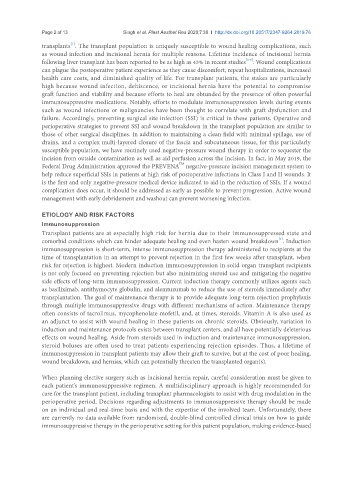Page 420 - Read Online
P. 420
Page 2 of 13 Singh et al. Plast Aesthet Res 2020;7:39 I http://dx.doi.org/10.20517/2347-9264.2019.76
[1]
transplants . The transplant population is uniquely susceptible to wound healing complications, such
as wound infection and incisional hernia for multiple reasons. Lifetime incidence of incisional hernia
[2-4]
following liver transplant has been reported to be as high as 43% in recent studies . Wound complications
can plague the postoperative patient experience as they cause discomfort, repeat hospitalizations, increased
health care costs, and diminished quality of life. For transplant patients, the stakes are particularly
high because wound infection, dehiscence, or incisional hernia have the potential to compromise
graft function and viability and because efforts to heal are obtunded by the presence of often powerful
immunosuppressive medications. Notably, efforts to modulate immunosuppression levels during events
such as wound infections or malignancies have been thought to correlate with graft dysfunction and
failure. Accordingly, preventing surgical site infection (SSI) is critical in these patients. Operative and
perioperative strategies to prevent SSI and wound breakdown in the transplant population are similar to
those of other surgical disciplines. In addition to maintaining a clean field with minimal spillage, use of
drains, and a complex multi-layered closure of the fascia and subcutaneous tissue, for this particularly
susceptible population, we have routinely used negative-pressure wound therapy in order to sequester the
incision from outside contamination as well as aid perfusion across the incision. In fact, in May 2019, the
TM
Federal Drug Administration approved the PREVENA negative-pressure incision management system to
help reduce superficial SSIs in patients at high risk of postoperative infections in Class I and II wounds. It
is the first and only negative-pressure medical device indicated to aid in the reduction of SSIs. If a wound
complication does occur, it should be addressed as early as possible to prevent progression. Active wound
management with early debridement and washout can prevent worsening infection.
ETIOLOGY AND RISK FACTORS
Immunosuppression
Transplant patients are at especially high risk for hernia due to their immunosuppressed state and
[1]
comorbid conditions which can hinder adequate healing and even hasten wound breakdown . Induction
immunosuppression is short-term, intense immunosuppression therapy administered to recipients at the
time of transplantation in an attempt to prevent rejection in the first few weeks after transplant, when
risk for rejection is highest. Modern induction immunosuppression in solid organ transplant recipients
is not only focused on preventing rejection but also minimizing steroid use and mitigating the negative
side effects of long-term immunosuppression. Current induction therapy commonly utilizes agents such
as basiliximab, antithymocyte globulin, and alemtuzumab to reduce the use of steroids immediately after
transplantation. The goal of maintenance therapy is to provide adequate long-term rejection prophylaxis
through multiple immunosuppressive drugs with different mechanisms of action. Maintenance therapy
often consists of tacrolimus, mycophenolate mofetil, and, at times, steroids. Vitamin A is also used as
an adjunct to assist with wound healing in these patients on chronic steroids. Obviously, variation in
induction and maintenance protocols exists between transplant centers, and all have potentially deleterious
effects on wound healing. Aside from steroids used in induction and maintenance immunosuppression,
steroid boluses are often used to treat patients experiencing rejection episodes. Thus, a lifetime of
immunosuppression in transplant patients may allow their graft to survive, but at the cost of poor healing,
wound breakdown, and hernias, which can potentially threaten the transplanted organ(s).
When planning elective surgery such as incisional hernia repair, careful consideration must be given to
each patient’s immunosuppressive regimen. A multidisciplinary approach is highly recommended for
care for the transplant patient, including transplant pharmacologists to assist with drug modulation in the
perioperative period. Decisions regarding adjustments to immunosuppressive therapy should be made
on an individual and real-time basis and with the expertise of the involved team. Unfortunately, there
are currently no data available from randomized, double-blind controlled clinical trials on how to guide
immunosuppressive therapy in the perioperative setting for this patient population, making evidence-based

